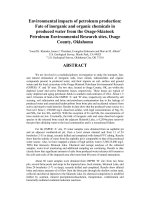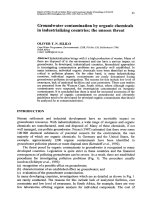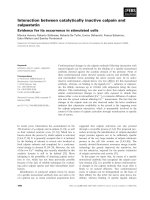Disruptive Technologies: Opportunities for Organic Chemicals in Information Technology docx
Bạn đang xem bản rút gọn của tài liệu. Xem và tải ngay bản đầy đủ của tài liệu tại đây (66.38 KB, 9 trang )
DIC Technical Review No.9 / 2003
53
報 文
1 Models of Innovation and
Disruptive Technology
Innovation, which is important for a company to
grow, has been studied by a number of scholars over
many years. Moreover, many models, such as the
Schumpeter I and II models, the Incremental-Radical
dichotomy model, the Abernathy-Clark model, the
Henderson-Clark model, the Utterback-Abernathy
model, the Tushman-Rosenkopf model, and Foster’s S
curve models, have been developed.
1)
Recently Christensen proposed a new framework for
the impact of sustaining and disruptive technological
changes. Christensen studied the history of hard disk
drive industry from the viewpoint of innovation,
disruption of technologies and companies in the
industry. He proposed a framework based on the
following findings.
2)
The first finding is the distinction
between sustaining technologies and disruptive
technologies. Sustaining technologies are technologies
that improve the performance of established products
in the mainstream market. Disruptive technologies are
new technologies that help develop new products,
whose performance may not be as good as the
established product but which bring new features and
new customer value. Products made by disruptive
technologies are generally cheaper, simpler, smaller,
and frequently, more convenient to use. This ancillary
performance from the viewpoint of the main market is
an important element for disruptive technologies. The
second finding is that sustaining technologies often
overshoot market requirements. When performance of
products based on sustaining technologies overshoot
the requirements of low-end users, they allow products
based on disruptive technologies to enter the low-end
market initially and the main market later on. The
disruptive technology may improve its performance and
compete with sustaining technology in the future. The
third finding is that established companies cannot
financially rationalize investment for disruptive
technologies. This is because profit of new business is
smaller than that of old business.
Established firms often fail when they are not able to
manage disruptive technologies and try to fight against
them with their existing technologies. One of the key
findings is that the companies that entered emerging
market has much higher success rate and higher sales.
3)
Another important suggestion of disruptive
technology is that there may be no market for
disruptive technology in the beginning or prior to the
commercialization. Learning and discovery are very
important to manage disruptive technology.
4)
Examples
of those disruptive technologies are Honda motorcycles
in North American market and Intel microprocessors
according to Christensen.
5)
Honda’s little 50 cc
Supercub was much smaller than other bikes and had
no market when it was first introduced. It created a new
market and then became an established motorbike
years later. Intel’s original microprocessor was used for
a Japanese calculator. This microprocessor was small
and simple but had limited capability compared with
the circuit used in the large computers. However, the
Intel’s microprocessors became the company’s robust
business years later.
Disruptive Technologies: Opportunities for Organic Chemicals in
Information Technology
OBI Naoki
Current information technology is based on a technology using silicon and related materials. This
paper will look at the possibilities for new technologies that use organic materials and new
manufacturing methods. Examples of innovations are light-emitting materials and electric circuits.
This paper examines technologies and companies from the perspective of disruptive technology
and business model. The results suggest that there are many opportunities for chemistry and
chemicals to be used in new technologies for the development of displays, light-emitting materials
and electric circuits. While the disruption of technologies is not easy to predict, however, it may
occur if successful innovations emerge.
54
DIC Technical Review No.9 / 2003
報 文
2 Selected New Technologies
This section will focus on new technologies such as
organic light-emitting diodes (OLED), solar cells and
electric circuits (conducting polymer). These
technologies are chosen not only because chemicals
play an important role but also because the products
and technologies are closely interrelated. Conducting
polymers for conventional use such as anti-static
applications are excluded from the discussion.
2.1 Organic Light Emitting Diodes (OLEDs)
There are two types of OLED: one is a low-molecular
type and the other is a polymer type. The technologies
for both are closely related to the technologies
previously developed for other applications such as
organic photoconductors (OPC) for copy machines and
p-n junction of organic compounds for solar cells. The
first organic light-emitting diode was developed in the
1960s and used anthroquinone. The breakthrough was
made by Kodak (published in 1987) using new light
emissive materials (tris-[8-hydroxyquinolynite]
aluminum). Organic light-emitting diode and conducting
polymer have received great attention, particularly so
since Prof. Hideki Shirakawa, Prof. Alan J. Heager and
Prof. Alan G. MacDiarmid received the Nobel Prize in
2000. The first OLED display was commercialized by the
Japanese electronics company, Pioneer Corporation, in
1997, and was used for electronics equipment for
automobiles.
OLED technology has advanced significantly in recent
years. The advantages of organic light-emitting diode
compared with liquid crystal display include response
time and viewing angle. Large-size, full-color displays
have not yet been developed. However, Sony has
announced in February 2001 its intention to complete
the building of the production technology for a 13-inch
full-color display with Universal Display Corporation
(UDC) by 2003
6)
Samsung announced the success of a
prototype of 15.1-inch full-color display in November
2001
7,8)
In March 2003 Chi Mei Optoelectronics (CMO)
announced a prototype of a 20-inch full-color display
based on OLEDs by International Display Technology
(IDTech).
9)
Among the companies and universities doing
leading research in organic light-emitting diode are
Cambridge Display Technology (CDT)
10,11)
, Uniax
Corporation
12,13)
, Universal Display Corporation
(UDC)
14,15)
, and Eastman Kodak Company.
16-20)
2.2 Conducting Polymer and Electric Circuits
Current inorganic microelectronic devices are
generally fabricated with techniques such as diffusion,
thermal oxidation, ion implantation, photolithography,
etching, evaporation, sputtering, chemical vapor
deposition (CVD) and high-temperature (>1000℃) film
growth. New technologies using organic compounds as
functional materials or a dispersion of inorganic
nanocrystals are emerging to make electric circuit,
transistor, memory, and related materials such as
transparent plastic electrode. Unlike the current silicon-
based technology, the new technology offers, if
successful, a simple and less expensive manufacturing
method (printing) for new applications. The potential
applications of electric circuits using polymers and
organic semiconductors are flat panel displays,
electronic tags, smart cards, anti-counterfeit devices,
medical diagnosis tools, memory, sensors, disposable
electronics and wearable computing. Among the
companies and universities doing leading research in
conducting polymers and electronic circuit are
Elecon
21,22)
, Plastic Logic
23-25)
, Lucent Technology / Bell
Labs
26,27)
, Rolltronics Corporation
28,29)
, FlexICs
30,31)
, MIT's
Media Lab
32,33)
and Alien Technology.
34)
2.3 Solar Cell
35-39)
The first application of the photovoltaic solar cell was
for satellites in the 1960s. In the 1970s, ground-based
applications started. Though the market is growing,
price and energy conversion efficiency are key for the
wide use of solar cells. Solar cells are clean and offer
infinite energy. On the other hand, solar energy has
wide fluctuation and low density as drawbacks. Most of
the solar cells used in practice are silicon-based. New
type solar cell called Graetzel cell started attracting a
great deal of attention in the 1990s. Graetzel cell uses
dye-sensitized titanium dioxide. Its use of liquid
electrolytes is one of the major disadvantages because
of the lack of stability and operation temperature.
University of Cambridge's Cavendish Laboratory and
the Max-Planck-Institute for Polymer Research reported
a new photovoltaic thin film or self-assembling solar
cell that uses the combination of crystalline dye and
discotic liquid crystal. Photodiodes made from the films
DIC Technical Review No.9 / 2003
55
報 文
show external quantum efficiencies of 34% around 490
nm wavelengths. The film can be made directly from
solution. Among the companies and universities are
Konarka
40)
, Sharp Corporation
41)
and University of
Cambridge.
42-45)
2.4 Electrophoresis Display
The concept of electrophoresis displays has been
known for years. Many other display technologies are
proposed for potential use such as electronic books.
Among those new technologies are the polymer
dispersed liquid crystal (PDLC) display, polymer
network (PN) liquid crystal display and cholesteric
liquid crystal display. Electrophoresis display started
attracting researchers as a potential application for
electronic book especially because of bistability (low
power consumption) and high contrast. Among the
organizations doing leading research in electrophoresis
display are E Ink
46-50)
and Gyricon.
51)
The E Ink electronic
display is a reflective electronic display that uses
electrophretic ink. The principal components of
electronic ink are microcapsules that contain positively
charged white particles and negatively charged black
particles suspended in a clear fluid. A black and white
image can be achieved by electro migration of black and
white particles. E Ink’s first commercial product is a
display called Ink-in-Motion
TM
. It is a motion display
with preset content for advertising at the point of
purchase.
2.5 Fabrication Process
The fabrication process is important in the
manufacture of products. Process innovation has
played an important role in many manufacturing
industries. Patterning technology is also important in
the manufacturing of many devises. Photolithography,
which uses photo mask and photo resist, is the
dominant method for patterning used in the
semiconductor industry. There are many technologies
for patterning. Among those are nanomachining such as
STM and AFM, printing, imprinting, soft lithography and
near-field phase-shifting photolithography.
52,53)
Soft lithography
54-56)
is a non-photolithographic
method based on self-assembly that has the potential to
fabricate nano- and micro-scale structures and allows
two-dimension structure control, and micro patterning
or three-dimensional control of devise structures. There
are some shortcomings, however, such as deformation
of the stamp, defects in the pattern and difficulty of
precision registration. Cost is expected to be reduced
(much lower cost). Traditional performance is not as
good as current lithography because soft lithography
may have poorer lateral dimensional stability and more
defects compared to the conventional fabrication
methods such as photolithography and CVD (chemical
vapor deposition). Soft lithography is not probably a
direct competitor to photolithography. Ancillary
performance is better because soft lithography process
produces smaller features than photolithography.
Bioassay for the pharmaceutical industry is an example
Table 1 Selected Technologies and Products
Technology OLED Electrophoresis Conducting (Semi-) Graetzel Cell
Polymer Conducting
Polymer/Organic
Chemicals
Product Display Display Circuit Circuit Organic solar
(ITO substitute) (organic cell
transistor)
Cost Down Down Down Down Down
(in future) (in future) (in future) (in future) (in future)
Traditional Up Depends on Up & down Up & down ?
Performance application
Ancillary Up Up Up Up Up
Performance (vs. LCD) (vs. LCD) (vs. ITO) (vs. inorganic) (vs. inorganic)
56
DIC Technical Review No.9 / 2003
報 文
of application of soft lithography. Surface Logix
produces advanced miniature bioassays based on the
work of Prof. George Whitesides in soft lithography.
57)
3 Analysis from the Viewpoint of
Disruptive Technology and
Business Model
Products, including proposed products that have not
yet been commercialized, examined in this study show
the general trends outlined in Table 1.
1. There are great uncertainties in traditional
performance.
2. Most of the technologies and products focus on low
price and better ancillary performance such as low
cost of manufacturing in organic electric circuit and
flexibility in conducting polymer for electrode.
3. Companies that are active in the fields studied are
different from the existing incumbent companies in
many cases.
4. Most of the technologies and products are not
focusing on expensive and better traditional
performance to compete with existing technologies
and products.
It is not easy to discuss disruptive technology because
there are many new technologies that compete with
existing products in many different ways and because
there are many possible disruptions in one category of
technologies and products. For example, many
companies are pursuing different approaches to organic
light emitting diode.
58,59)
Whether or not there is
replacement or disruption of companies depends on the
performance the company achieves and the strategy it
takes.
If we compare liquid crystal display with organic light
emitting diode, for example, organic light emitting diode
has a potential to become disruptive technology. The
definition of traditional and ancillary performance
depends on the applications for organic light emitting
diode. It is reasonable to conclude that organic light
emitting diode do not have better traditional
performance with respect to color reproduction and
lifetime at this point. However, organic light emitting
diodes offer better performance with respect to a wide
visual angle, a high response time and a thinner
structure than liquid crystal display. This performance
allowed organic light emitting diode to be used in
applications such as audio appliance for automobiles
and PDA, while they are competing with liquid crystal
display in terms of traditional performance. Whether or
not there is a disruption of technologies depends on the
performance of the products. It is important for organic
light emitting diode to create a market such as lighting
and very different product such as a display for clothes
because the market may be limited if the product is a
replacement of existing liquid crystal display.
60,61)
It is interesting that the liquid crystal display has been
widely accepted as a display even though liquid crystal
display is generally more expensive and has lower
visual performance than CRT. This is because the
ancillary performance of liquid crystal display, size and
low power consumption, is essential for mobile
applications. In other words, mobility of display is more
important than traditional performance in the case of
applications for mobile applications. If the market
values the ancillary performance or if the ancillary
performance opens a new market as in the case of
liquid crystal display, then organic light emitting diode
have great potential to successfully create value.
It is interesting that organizations that are active in
the development of new technologies studied in this
paper are quite often different from the incumbent
companies in the industry itself. For example,
Cambridge Display Technology (CDT), Universal
Display Corporation (UDC), Uniax, and Kodak are
actively developing organic light emitting diode
material, however, these companies are not major
players in the liquid crystal display market. On the other
hand, IBM and Lucent Technologies are developing new
technologies (organic electric circuit) in addition to
developing current technologies (silicon base
technologies).
Performance /cost is an important factor for organic
electronics for diffusion. Main analyzed the
performance/cost and advantages for light emitting
polymers. She suggested that light-emitting polymer for
TV, computer monitor is a revolutionary innovation,
and that for wireless application is an architectural
innovation.
62)
In conclusion, the possibility that the above
technologies or products may become disruptive
DIC Technical Review No.9 / 2003
57
報 文
technologies cannot be excluded because the overall
observation fits the definition of a disruptive
technology.
1. The companies believe that products such as
organic light emitting diode, electric circuit and
organic solar cells are less expensive when the
products are in full production (organic light emitting
diode, electric circuit by coating or self-assembly).
2. The companies are focusing on ancillary
performance (for example flexibility).
3. Traditional performance is probably not as good as
that for current products.
4. Active research groups are different from
mainstream groups in the industry.
However, whether or not a new technology becomes a
disruptive technology strongly depends on the
performance of a new product; in other words, it
depends on the existence of innovation and scientific
discoveries.
The business models vary by company and in some
cases is still not clear. The business models include
most of the possible models for chemical and materials
companies including the following:
1. Manufacturing and sales of materials
2. Manufacturing and sales of components
3. Manufacturing and sales of final products
4. Technology licensing
Many strategic partnerships are observed in the areas
studied. For example, CDT has formed partnerships and
alliances with various companies such as materials,
components and OLED panel manufacturing
companies. Incumbent companies also have similar
alliances and partnerships. Among the models,
licensing-only business model seems to be the least
attractive business model among the companies
studied.
Fig.1 shows the source of the key technology for the
companies studied. The original source of technologies
is not clear for some of the start-up companies.
However, many start-up companies started with a
technology originally developed at a university or
national laboratory. Professors and researchers from
the organizations where the original research was
conducted are sometimes involved in the start-up
companies. Large companies have several choices;
internal R&D, equity investment, alliances and
acquisitions. Evaluation of the source of the key
technology for incumbent companies was not clear in
some cases because internal research activities have
not been studied. The fact that companies pursued
sources of new technologies outside their organizations
does not necessarily mean that they weren’t also
conducting in-house research at the same time.
4 Conclusion
Followings are the summary of general observations
in the fields studied.
1. New technologies for, and companies producing,
organic light emitting diodes (OLED), organic solar
cells, conducting polymers for electric circuit, organic
transistors, single molecular memory, and
manufacturing architectures are emerging.
2. The new technologies compete with existing
technologies.
3. The new technologies are focusing on
inexpensiveness and ancillary performance.
4. Many of the new technologies are immature.
5. New concepts of manufacturing technologies are
also emerging.
6. New technologies tend to emerge from
organizations other than mainstream technology
companies.
7. Scientific research plays an important role.
8. The key technologies of start-up companies tend to
originate from academic institutions and national
Fig.1 Matrix analysis of source of key technology for
start-ups and incumbent companies. (Company
names are shown by alphabet.)
58
DIC Technical Review No.9 / 2003
報 文
laboratories.
9. Leading technology development companies are for
the most part seeking strategic partners.
10. Start-up companies and incumbent companies are
developing similar technologies in many cases.
11. It is not clear whether new technologies are
disruptive technologies in the beginning stages.
Observing the new technologies studied reveal the
following general trends.
1. They focus on inexpensiveness.
2. Initial product performance may not be as good as
that of the current product.
3. New technologies are not emerging from
mainstream research groups.
While the above three trends suggest the technologies
studied may be disruptive technologies, it is too early to
make a definitive claim. Ultimately, it will depend on the
performance achieved. It seems that disruption of
technologies is “a result” and is hard to predict when
the technology is immature. In the case of organic light
emitting diodes (OLEDs), the fact that OLEDs started
taking off as a business in some applications, such as
car audio displays for example, and that over all
observations follow the concept of disruptive
technology suggests the possibility that a disruption of
technology (from liquid crystal displays to organic light
emitting diodes) cannot be excluded. Whether or not
OLEDs become a disruptive technology, however,
depends on the future innovation.
Current information technology is based on silicon-
base integrated circuits, CRTs, and liquid crystal
displays. The transistor was invented by Dr. John
Bardeen, Dr. Walter Brattain, and Dr. William Shockley
at Bell laboratories in 1947 in the US. The transistor
replaced the vacuum tube, which was invented by Sir
John Ambrose Fleming (University College) in 1904 in
England. The integrated circuit was invented by Mr.
Jack Kilby at Texas Instruments in 1958 in the US. The
integrated circuit market has grown considerably since
Kilby’s discovery and in 2000 stood at $177 billion. The
end equipment market is worth nearly $1,150 billion.
63)
The CRT was invented by Dr. Karl Ferdinand Braun in
1897 in Germany. CRT sold 240 million sets ($25 billion)
in 1997.
64)
Liquid crystal display was invented by RCA in
the 1960s in the US. Liquid crystal displays sold 32
million sets (910 billion yen, approximately $9 billion) in
1997.
65)
Those data show that silicon-base integrated
circuits, CRTs, and liquid crystal displays have created
great value.
Dr. Gordon E. Moore, of Fairchild Semiconductors
(now Intel Corporation), predicted that the number of
transistors per integrated circuit would double every
two years and that this trend would continue through
1975.
66)
Moore's Law has been maintained for far longer
than initially predicted because of continuous
innovations. The number of transistors per chip
increased from 5,000 (Intel 8080) in 1974 and had
reached 42,000,000 (Pentium 4) by 2000.
67)
However, the
cost of manufacturing plants has also increased
significantly. Each plant cost $3 billion in 1998.
68)
It is
estimated that the cost of a plant will increase to $50
billion in 2010 assuming that the cost continues to
increase at the same rate in the past.
69)
Although silicon technology continues to improve, it
is not clear how much further it can improve. Is there a
possibility that new technologies such as plastic
electronics could replace some part of the silicon
technology or create a new market that would result in
silicon technology having difficulty creating value in the
future? Those questions are hard to answer. However,
the possibility cannot be excluded because there is
much research and development attempting to create
value in the area of organic light emitting diodes
(OLED), organic solar cells, conducting polymers for
electric circuits, organic transistors, molecular memory,
and manufacturing architectures.
本報はマサチューセッツ工科大学スローンスクールに
提出した論文の一部を加筆修正したものである。
References
1) Allan Afuah, Innovation Management (New York,
NY: Oxford University Press, 1998), p.13.
2) Clayton Christensen, The Innovator’s Dilemma
(Boston, MA: Harvard Business School Press,
1997).
3) Ibid., p. P121.
4) Clayton Christensen, “Discovering new and
emerging markets”, Chemtech (September 1997),
p. 42.
DIC Technical Review No.9 / 2003
59
報 文
5) Ibid.
6) Sony, home page
( />2/01-007/).
7) Samsung, home page
( />8) Nikkei Electronics On Line
( />9) International Display Technology Inc., home page,
( />ml)
10) Cambridge Display Technology, home page
().
11) The Japanese Research Association for Organic
Electronics Materials, Yuki LEDsoshi no
nokosaretajyuuyokadai to jitsuyokasenryaku
[Important issues and commercialization strategies
of organic LED devise] (Tokyo: Bunshin Publishing
Co., 1999), p.145.
12) California Council on Science and Technology, vol.
6, issue 1 (January 2001),
( />.html#ucsb).
13) Uniax, home page ().
14) Universal Display Corporation, home page
().
15) V. Bulvoc, R. Deshpande, M. E. Thompson, S. R.
Forrest, “Tuning the color emission of thin film
molecular organic light emitting devises by the solid
solvation effect”, Chemical Physics Letters vol.
308 (1999), pp. 317-322.
16) Kodak, home page ().
17) The Japanese Research Association for Organic
Electronics Materials, Yuki LEDsoshi no
nokosaretajyuuyokadai to jitsuyokasenryaku
[Imprtant issus and commercialization strategies of
organic LED devise] (Tokyo:Bunshin Publishing
Co.,1999), p.1.
18) C. W. Tang and S. A. VanSlyke, “Organic
electroluminescent diodes”, Applied Physics
Letters, vol. 70 (1987), p. 913.
19) C. W. Tang and S. A. VanSlyke,
“Electroluminescence of doped organic thin
films”, Journal of Applied Physics, vol. 65 (1989),
p. 3610.
20) C. W. Tang, “Two-layer organic photovoltaic
cell”, Applied Physics Letters, vol. 48 (1986), p.
183.
21) Elecon, Inc., home page
().
22) Elecon Technical Report, PIN-EF02-02-28.
23) Plastic Logic, home page
().
24) Chemical and Engineering News, vol.79 no. 1
(January 2001), p. 26.
25) Tracy Staedter, “Plastic Logic”, Technology
Review (September 2001),
( />26) Bell labs, home page (www.bell-labs.com).
27) Barbara Goss Levi, “New Printing Technologies
Raise Hopes for Cheap Plastic Electronics”,
Physics Today vol. 54, no. 2 (2001), p. 20.
28) Rolltronics Corporation, home page
().
29) Wade Roush, “Flexible transistor on a roll”,
Technology Review (January 2002).
30) FlexICs Inc., home page ().
31) Mark LaPedus, “Here come plastic ICs from
startup FlexICs”, Semiconductor Business News
(September 26, 2001),
( />OEG20010926S0027).
32) MIT Media Lab., home page
().
33) Brent A. Ridley, Babak Nivi, and Joseph M.
Jacobson, “All-Inorganic Field Effect Transistors
Fabricated by Printing”, Science, vol. 286 (1999)
pp. 746-749.
34) Alien Technology, home page
(
35) The New Energy and Industrial Technology
Development Organization (NEDO), home page
(
36) Sharp Co., home page
( />37) CEA/DCom - INTERNET WEB SITE
( />38) Nippon Keizai Shinbun, April 19 (2002).
39) Solar Cell, Kinozairyo [Functinal Materials] vol. 16,
no. 4 (April 1996) p. 57.
40) Konarka, home page
().
60
DIC Technical Review No.9 / 2003
報 文
41) Nippon Keizai Shinbun, April 19 (2002).
42) Nippon Keizai Shinbun, April 19 (2002).
43) Jenny Nelson, “SOLAR ENERGY: Solar Cells by
Self-Assembly?”, Science, vol. 293 (2001), pp.1059-
1060.
44) L. Schmidt-Mende, A. Fechtenkter, K. Mlen, E.
Moons, R.H. Friend, J.D. MacKenzie “ Self-
organized discotic liquid crystals for high efficiency
organic photovoltaics” vol. 293 (2001), pp. 1119-
1122.
45) Pamela Zurer “ SELF-ASSEMBLING SOLAR
CELLS-Crystalline dye and liquid crystal self-
organize into photovoltaic thin film”, Chemical &
Engineering News, vol 79, no.33 (August 13, 2001),
p. 9.
46) E Ink, home page ().
47) Barrett Comiskey, Jalbert, Hidekazu Yoshizawa,
and Joseph Jacobson, “An Electrophoretic Ink for
All-Printed Reflective Electronic Displays”,
Nature, vol. 394 (1998), p. 253.
48) Flat Panel Display 2001 part 1 and part 2 (Tokyo:
Nikkei Business Publications, Inc., 2001).
49) Toppan Printing Co., Ltd., home page.
( />474.html).
50) Steve Ditlea, “The Electronic Paper Chase”
Scientific American (November 2001).
51) Xerox Parc, home page
( />52) Younan Xia, John,Rogers, Kateri Paul, and Gerorge
Whitesides, “ Unconventional Methods for
Fabricating and Patterning Nanostructure” ,
Chem. Rev., vol. 99, no. 7 (1999), p.1823-1848.
53) National Institute of Advanced Industrial Science
and Technology (AIST), press release
( />21/pr20020121.html).
54) David H. Gracias, Joe Tien, Tricia L. Breen, Carey
Hsu, and George M. Whitesides,
“Forming Electrical Networks in Three
Dimensions by Self-Assembly”, Science, vol. 289
(August 18, 2000), pp. 1170-1172.
55) Younan Xia and Gerorge Whitesides, “SOFT
LITHOGRAPHY”, Annu. Rev. Mater. Sci. vol. 28
(1998), pp. 153-184.
56) Surfacelogix, home page
().
57) Surfacelogix, home page
().
58) Flat Panel Display 2001 part 1 and part 2 (Tokyo:
Nikkei Business Publications, Inc., 2001).
59) Tsuyoshi Numagami, Ekisho dhisupurei no
gijyutsukakushinshi [History of technological
innovation of liquid crystal display] (Tokyo:
Hakutoshobou, 1999), p. 351.
60) Asahi News Paper ().
61) Arpad Bergh, George Craford, Anil Duggal, and
Roland Haitz,“The Promise and Challenge of
Solid-State Lighting”, Physics Today, vol. 54, no.
12, (December 2001), p. 42.
62) Elicia M A. Main, “Innovation and Adoption of
New Materials”, Ph.D. Thesis, (September 2000),
p.97.
63) Texas Instrument home page
( />html)
DIC Technical Review No.9 / 2003
61
報 文
本社 技術部
課長
小尾 直紀
O
BI Naoki
64) Denshibuhinnenkan 1998 [Annual report of
electronic parts 1998] (Tokyo: Chunichisha, 1998),
p. 197.
65) Ibid., pp.139-140. Number of sets includes middle
and large size panels and excludes small size
panels.
66) Intel home page
( />htm)
67) Ibid.
68) Michael Brooks,“Quantum Computing and
Communications”(London, Springer Verlag,
1999), p.66.
69) Ibid.









